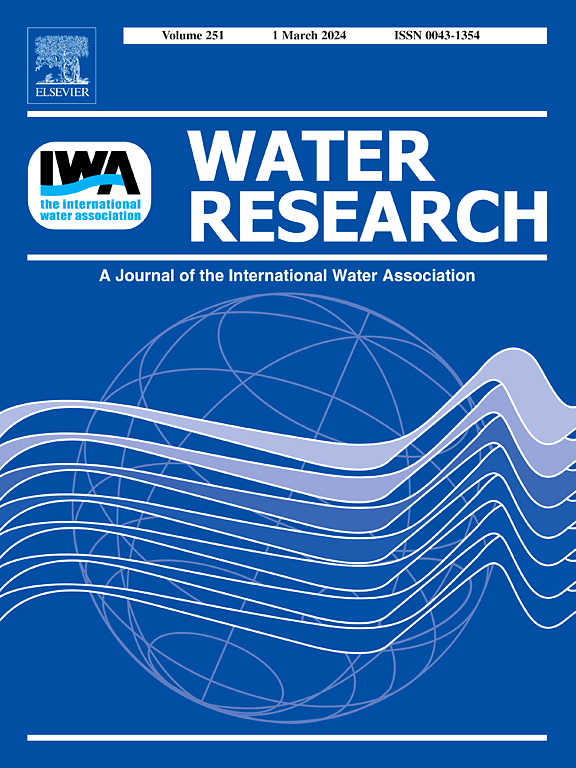Understanding the structure, distribution, and retention of nanoplastics in montmorillonite nanopore by multi-scale computational simulations
IF 11.4
1区 环境科学与生态学
Q1 ENGINEERING, ENVIRONMENTAL
引用次数: 0
Abstract
The interfacial adsorption, aggregation and deposition processes of nanoplastics (NPs) on clay mineral surfaces critically regulate their environmental mobility, transformation pathways, and ecotoxicological risks in aquatic ecosystems. A quantitative understanding of the nanoscale interfacial processes is essential. This study employs molecular dynamics (MD) simulations and density functional theory (DFT) calculations to elucidate the aggregation and deposition mechanisms of three types of NPs in their pristine and aged states in the nanopore solution of montmorillonite (Mt). In the wet environment, NPs tend to form aggregates in the nanopore and migrate in solution, increasing environmental risk, while in the dry environment, NPs are more likely to deposit on the basal surface to form larger aggregates, consequently reducing their mobility. Results show hydrophobic interactions play as the primary driving force for the aggregation of pristine NPs, and both hydrophilic and hydrophobic interactions contribute to the aggregation of aged NPs. Aged NPs exhibit stronger binding affinity to Mt through mechanism such as Ca²⁺ bridging and hydrogen bonding, compared to their pristine counterparts. DFT calculations further reveal the formation of hydrogen bonds between the hydroxyl groups of aged NPs and the tetrahedral oxygen atoms in Mt. Through atomic-level characterization of interfacial processes, this work establishes a predictive framework for NP environmental behavior by resolving migration dynamics and retention processes in nanopore water.


通过多尺度计算模拟了解纳米塑料在蒙脱石纳米孔中的结构、分布和滞留情况
纳米塑料 (NPs) 在粘土矿物表面的界面吸附、聚集和沉积过程对其在水生生态系统中的环境流动性、转化途径和生态毒理学风险起着至关重要的调节作用。定量了解纳米级界面过程至关重要。本研究利用分子动力学(MD)模拟和密度泛函理论(DFT)计算,阐明了三种 NPs 在蒙脱石(Mt)纳米孔溶液中原始状态和老化状态下的聚集和沉积机制。在潮湿环境中,NPs 往往在纳米孔中形成聚集体并在溶液中迁移,从而增加了环境风险;而在干燥环境中,NPs 更有可能沉积在基底表面形成较大的聚集体,从而降低了其流动性。结果表明,疏水相互作用是原始 NPs 聚集的主要驱动力,而亲水和疏水相互作用都有助于老化 NPs 的聚集。与原始 NPs 相比,老化 NPs 通过 Ca²⁺ 桥接和氢键等机制与 Mt 表现出更强的结合亲和力。DFT 计算进一步揭示了老化 NPs 的羟基与 Mt 中的四面体氧原子之间形成的氢键。通过对界面过程的原子级表征,这项研究通过解析纳米孔水中的迁移动力学和滞留过程,为 NP 的环境行为建立了一个预测框架。
本文章由计算机程序翻译,如有差异,请以英文原文为准。
求助全文
约1分钟内获得全文
求助全文
来源期刊

Water Research
环境科学-工程:环境
CiteScore
20.80
自引率
9.40%
发文量
1307
审稿时长
38 days
期刊介绍:
Water Research, along with its open access companion journal Water Research X, serves as a platform for publishing original research papers covering various aspects of the science and technology related to the anthropogenic water cycle, water quality, and its management worldwide. The audience targeted by the journal comprises biologists, chemical engineers, chemists, civil engineers, environmental engineers, limnologists, and microbiologists. The scope of the journal include:
•Treatment processes for water and wastewaters (municipal, agricultural, industrial, and on-site treatment), including resource recovery and residuals management;
•Urban hydrology including sewer systems, stormwater management, and green infrastructure;
•Drinking water treatment and distribution;
•Potable and non-potable water reuse;
•Sanitation, public health, and risk assessment;
•Anaerobic digestion, solid and hazardous waste management, including source characterization and the effects and control of leachates and gaseous emissions;
•Contaminants (chemical, microbial, anthropogenic particles such as nanoparticles or microplastics) and related water quality sensing, monitoring, fate, and assessment;
•Anthropogenic impacts on inland, tidal, coastal and urban waters, focusing on surface and ground waters, and point and non-point sources of pollution;
•Environmental restoration, linked to surface water, groundwater and groundwater remediation;
•Analysis of the interfaces between sediments and water, and between water and atmosphere, focusing specifically on anthropogenic impacts;
•Mathematical modelling, systems analysis, machine learning, and beneficial use of big data related to the anthropogenic water cycle;
•Socio-economic, policy, and regulations studies.
 求助内容:
求助内容: 应助结果提醒方式:
应助结果提醒方式:


